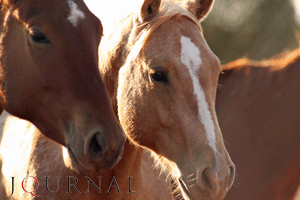 Galveston County, Texas
Galveston County, Texas
Via the Texas Animal Health Commission, February 6, 2015
The Texas Animal Health Commission is investigating two confirmed cases of the equine herpesvirus type-1 (EHV-1) in horses at two different stables in northwestern Galveston County. Laboratory tests conducted on nasal swabs were positive for the neuropathogenic strain of EHV-1. There is no indication of involvement of horses outside of those stabled at the two facilities.
The first confirmed horse showed signs of respiratory illness on January 24 and veterinary care was sought. Prior to death some changes in behavior were present but the usual neurologic symptoms associated with EHV-1 had not developed. The second horse that tested positive for EHV-1 showed a fever and respiratory symptoms and is under close veterinary care. Both stables have been placed under quarantine, and investigation continues.
Direct horse-to-horse contact is a common route of transmission of the virus, but indirect transmission is also important. This occurs when infectious materials (nasal secretions, fluids from abortions, etc.) are carried between infected and non-infected horses by people or inanimate objects such as buckets, tack, trailers, etc. Aerosol transmission can also occur when infectious droplets are inhaled. The source of infectious droplets is most often respiratory secretions.
Symptoms of EHV-1 include fever, which is one of the most common clinical signs and often precedes the development of other signs. Respiratory signs include coughing and nasal discharge. Neurologic signs associated with EHV-1 are highly variable, but often the hindquarters are most severely affected. Horses with EHV-1 may appear weak and uncoordinated. Urine dribbling and loss of tail tone may also be seen. Severely affected horses may become unable to rise.
It is important to remember that none of these signs are specific to EHV-1, and diagnostic testing is required to confirm EHV-1 infection. Many horses exposed to EHV-1 never develop clinical signs. If you suspect your horse has been exposed to EHV-1, contact your veterinarian. In general, exposed horses should be isolated and have their temperatures monitored twice daily. If an exposed horse develops a fever or other signs consistent with EHV-1, diagnostic testing may be performed. Always practice effective biosecurity before, during and after equine events and when introducing new horses to a premises.
For more information on protecting your livestock from EHV-1, contact your local TAHC regional office or call 1-800-550-8242 or visit www.tahc.texas.gov.
Albermarle County, Virginia
Via the Virginia Department of Agriculture and Consumer Services, February 9
A VDACS veterinarian visited the Virginia equine herpesvirus type-1 (EHV-1) equine premises again this morning to evaluate the current situation. Even though the index horse continues to drag his rear feet when walking, he is afebrile and is able to gallop. No other horses on the premises have been febrile (fever of 101.5 degrees Fahrenheit) or neurologic.
Via VDACS, February 5
VDACS was notified of a positive result for equine herpesvirus myeloencephalopathy (EHM) on a horse displaying neurologic signs in western Albemarle County, Northwest of Charlottesville. The affected horse is located at a boarding stable with 14 other horses at the facility. VDACS contacted the stable manager and placed the facility under quarantine – no horses are allowed to exit or enter the premises until the quarantine is released.
The affected horse is a 14-year-old gelding that showed symptoms on Saturday, January 31, became recumbent on Sunday, February 1, but is now stable. Samples were taken by a private veterinarian and the result was reported to VDACS February 5. An epidemiologic investigation is underway; initial findings indicate that only one exposed horse from the facility has left the premises within the last 14 days, and that horse went out of state.
VDACS will post updates on the situation here as needed, as well as on its Facebook page and on Twitter.
EHV-1 Preparedness
Please use these resources regarding EHV-1 and biosecurity, brought to you by The American Quarter Horse Journal:
- Travel Safely: Good biosecurity both at home and on the road will help keep your horses healthy.
- The Facts on EHV-1: Recognize the signs of equine herpesvirus-1 and learn how to protect your horse from the risks of the virus.


You must be logged in to post a comment Login